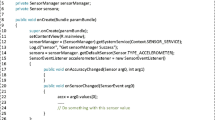Abstract
In today’s working and shopping environment a lot of sources are present that collect data of people located in those environments. The data gathered by devices such as video cameras, RFID tags, use of credit cards etc. can be combined in order to deduce information which cannot be “measured” directly. In this paper we introduce deduction rules that help to describe which information can be inferred from which sources. Using these rules all information that can be gathered by a pervasive system can be identified and linked to the sources of the raw input data. By that the pervasive system is represented as an information flow graph. In order to enhance privacy we use this graph to determine the data sources, e.g. video cameras or RFID tags, that need to be switched off to adapt a given system to privacy requirements of a certain person. Due to the fact that we do not consider an individual device a data source but cluster those devices into a single source of a certain type, our approach scales well even for large sensor networks. Our algorithms used to build and analyze the information flow graph offer low calculation complexities. Thus, they are well suited to be executed on mobile devices giving the end user back some control over her/his data. Even if she/he cannot influence the system, she/he at least knows which information is exposed to others.
Preview
Unable to display preview. Download preview PDF.
Similar content being viewed by others
References
Weiser, M.: The Computer for the 21st Century. In: Hot Topic: Ubiquitous computing, pp. 71–72. IEEE Computer, Los Alamitos (1993)
Bohn, J., Coroama, V., Langheinrich, M., Mattern, F., Rohs, M.: Living in a World of Smart Everyday Objects – Social, Economic, and Ethical Implications. Journal of Human and Ecological Risk Assessment 10(5), 763–786 (2004)
Wren, C.R., Azarbayejani, A., Darrell, T., Pentland, A.P.: Pfinder: Real-Time Tracking of the Human Body. IEEE Transactions on Pattern Analysis and Machine Intelligence 19(7) (1997)
BehaviorIQ, Brickstream, http://www.brickstream.com
Chekmenev, S.Y., Rara, H., Farag, A.A.: Non-contact, Wavelet-based Measurement of Vital Signs using Thermal Imaging. In: The first international conference on graphics, vision, and image processing (GVIP), Cairo, Egypt, pp. 107–112 ( December 2005)
Garbey, M., Sun, N., Merla, A., Pavlidis, I.: Contact-Free Measurement of cardiac pulse based on the analysis of thermal imagery. Technical report number UH-CS-04-08, Department of computer science, University Houston, Texas (December 2004)
Bissig, M.: Office Monitoring with Sensor Networks. Project report, Department of computer science, University Bern (April 2006)
TAUCIS – Technikfolgenabschätzung: Ubiquitäres Computing und Informationelle Selbstbestimmung. German Federal Ministry of Research and Technology
Intelligent Long Range Tags, IDENTEC SOLUTIONS GmbH, Hertzstrasse 10, 69469 Weinheim, Germany
Gruteser, M., Grunwald, D.: Anonymous Usage of Location-Based Services Through Spatial and Temporal Cloaking. In: ACM/USENIX International Conference on Mobile Systems, Applications, and Services (MobiSys) (2003)
Langendörfer, P., Kraemer, R.: Towards User Defined Privacy in location-aware Platforms. In: Proceeding of the 3rd international Conference on Internet computing, CSREA Press, USA (2002)
Synnes, K., Nord, J., Parnes, P.: Location Privacy in the Alipes platform. In: Proceedings of the Hawai’i International Conference on System Sciences (HICSS-36), Big Island, Hawai’i, USA (January 2003)
Wagealla, W., Terzis, S., English, C.: Trust-based Model for Privacy Control in Context-aware Systems. In: Dey, A.K., Schmidt, A., McCarthy, J.F. (eds.) UbiComp 2003. LNCS, vol. 2864, Springer, Heidelberg (2003)
PRIME: Privacy and Identity Management for Europe, http://www.prime-project.eu.org/
Brar, A., Kay, J.: Privacy and Security in Ubiquitous Personalized Applications. In: UM 2005 Workshop on Privacy-Enhanced Personalization (2005)
Langheinrich, M.: A Privacy Awareness System for Ubiquitous Computing Environments. In: Borriello, G., Holmquist, L.E. (eds.) UbiComp 2002. LNCS, vol. 2498, pp. 237–245. Springer, Heidelberg (2002)
Robinson, P., Beigl, M.: Trust Context Spaces: An Infrastructure for Pervasive Security. In: First International Conference on Security in Pervasive Computing (2003)
Denning, D.: Cryptography and Data Security. Addison-Wesley, Reading (1982)
Ortmann, S., Langendörfer, P., Maaser, M.: A Self-Configuring Privacy Management Architecture for Pervasive Systems. In: 5-th ACM International Workshop on Mobility Management and Wireless Access (MobiWAC), October 22, 2007 Chania, Crete Island, Greece (2007)
Author information
Authors and Affiliations
Editor information
Rights and permissions
Copyright information
© 2007 Springer-Verlag Berlin Heidelberg
About this paper
Cite this paper
Ortmann, S., Langendörfer, P., Maaser, M. (2007). Enhancing Privacy by Applying Information Flow Modelling in Pervasive Systems. In: Meersman, R., Tari, Z., Herrero, P. (eds) On the Move to Meaningful Internet Systems 2007: OTM 2007 Workshops. OTM 2007. Lecture Notes in Computer Science, vol 4806. Springer, Berlin, Heidelberg. https://doi.org/10.1007/978-3-540-76890-6_5
Download citation
DOI: https://doi.org/10.1007/978-3-540-76890-6_5
Publisher Name: Springer, Berlin, Heidelberg
Print ISBN: 978-3-540-76889-0
Online ISBN: 978-3-540-76890-6
eBook Packages: Computer ScienceComputer Science (R0)




